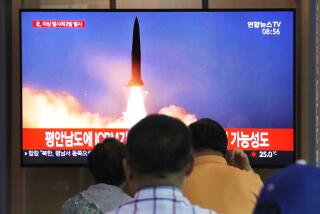Long-Term Chernobyl Toll Estimated at 24,000
- Share via
VIENNA — A tentative estimate of long-term health effects from the Chernobyl nuclear accident four months ago indicates that radioactive contamination may result in 24,000 cancer deaths in the Soviet Union over the next 70 years, senior officials of two international nuclear organizations said Tuesday.
No authoritative estimates are yet available on the long-term effects of contamination beyond the Soviet borders. Large areas of Europe and parts of the rest of the world were affected by radioactive fallout from the Chernobyl plant.
Most of the Soviet deaths would be expected from long-term contamination of the soil and the food chain by cesium-137, a major component of fission wastes expelled when the reactor exploded and caught fire on April 26.
Less than 1% Increase
The officials emphasized, however, that this increase in cancer deaths will probably not be visible in Soviet health statistics, as it would represent an increase of less than 1% over the natural death rate from cancer in affected areas of the Soviet Union.
They compared this number to an estimated 100,000 cancer deaths among the same population that might be expected over the next 70 years from natural background radiation.
“There will be health effects,” Dr. Morris Rosen, chief of the International Atomic Energy Agency’s reactor safety division, said in presenting the estimate of 24,000 deaths.
But, statistically, he said at a news conference, “you will not be able to measure this increase, it will be so small.”
His estimate was endorsed by Dan Beninson, the chairman of the London-based International Commission on Radiological Protection, a non-governmental group that has coordinated the setting of world radiation safety standards since the 1920s.
Number Could Be Smaller
Beninson said, however, that the number may represent an upper limit and could prove much smaller in reality.
The two officials presented their estimate, based on Soviet data, on the second day of an international conference organized by the IAEA at which the Soviet government is providing a detailed technical description of the Chernobyl accident and its aftermath. About 500 officials from the nuclear agencies of 47 countries are taking part, according to the IAEA.
A senior Soviet radiation protection official, Dr. Leonid A. Ilyin, took part in the news conference at which Morris and Beninson provided their estimate, but the Soviet official offered no comment on their figures. In private conversations at the meeting, however, Soviet officials have indicated that they believe an estimate of 24,000 eventual deaths is reasonable.
So far the Soviet Union has recorded 31 deaths from intense radiation suffered by workers at the Chernobyl plant, 60 miles north of Kiev in the Ukraine, which exploded in the early hours of April 26. Soviet authorities have acknowledged that the accident was caused by a combination of operator errors and design defects in the 1,000-megawatt plant, one of 15 in the Soviet Union.
The long-term health effects of the Chernobyl disaster will be the subject of scientific debate for years to come, as researchers differ over a number of assumptions that go into any estimate of long-term radiation effects.
Based on Soviet Estimates
The figure of 24,000 is based on Soviet estimates of radiation exposure among two groups of the population, the 135,000 people who were evacuated from a zone within an 18-mile radius of the plant, beginning the day after the accident, and about 75 million people living in 11 areas of the Ukraine, Byelorussia and the Russian Republic where contamination was judged to be significant.
According to Soviet figures, the 135,000 evacuees suffered an average exposure of 11.8 rems (the rem is a unit of exposure that relates an amount of radiation to its biological effect in humans), for a collective dose of 1.6 million man-rems.
Using a widely accepted estimate that every 10,000 man-rems of exposure in a large population can be expected to cause one additional cancer death beyond the natural rate of occurrence, the IAEA’s Rosen said that about 160 additional deaths could be expected among the evacuees over a 70-year lifetime.
In a detailed report submitted to the IAEA conference, the Soviets have said that the 75 million people living in affected areas of the country outside this zone may eventually receive a total dose over the same period of 29 million man-rems, a figure Rosen and Beninson said suggests another 2,900 cancer deaths.
In addition, the Soviet report indicates that the same 75 million people may absorb a much larger internal dose of 210 million man-rems from cesium in the food chain. This, Rosen said, would imply another 21,000 cancer deaths in 70 years.
9.5 Million Cancer Deaths
The total of these three numbers, or about 24,000, would equal less than 0.3% of the 9.5 million cancer deaths the Soviets say would occur naturally among the same population over the same period.
The two researchers emphasized that these numbers represent only an “order of magnitude” guess, and involve controversial assumptions that have polarized the scientific community for many years.
More to Read
Sign up for Essential California
The most important California stories and recommendations in your inbox every morning.
You may occasionally receive promotional content from the Los Angeles Times.










